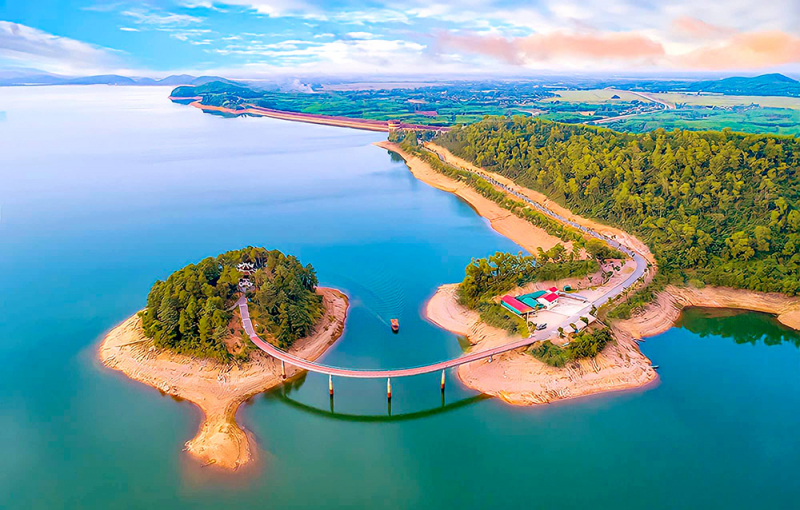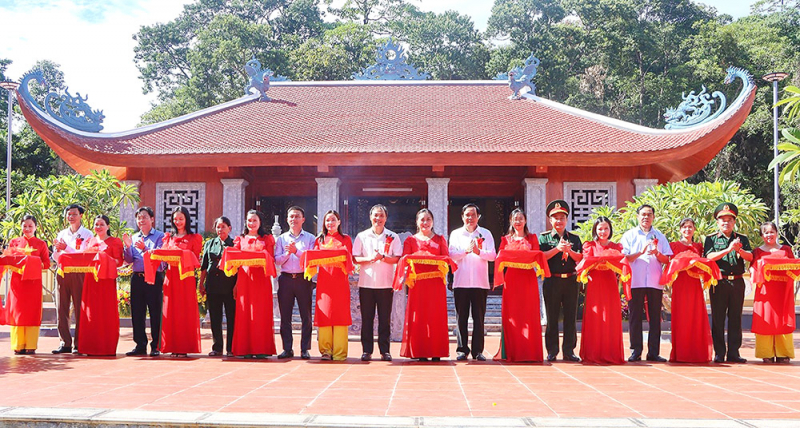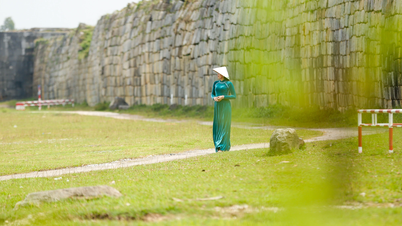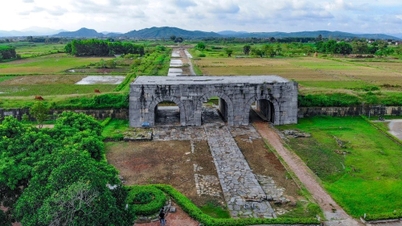Ke Go Lake, located in Cam My commune, Cam Xuyen district ( Ha Tinh province), has long been known as the largest irrigation project in North Central Vietnam. Construction began in 1976 and was completed just 3 years later, instead of the originally planned 6 years.
This project also became more widely known after the late musician Nguyen Van Ty included it in his song "The People Building Ke Go Lake," which expressed the burning desire and aspirations of the Party Committee and people of the former Nghe Tinh province in the process of rebuilding their homeland and country after the reunification of the nation.
War relics in the heart of Ke Go Lake.
To build the Ke Go irrigation project, nearly 20 years prior, on May 16, 1957, President Ho Chi Minh visited the army and people of Ha Tinh province. During a meeting with the provincial Party committee and people, he said: "Ha Tinh must review the Ke Go project documents and study them beforehand so that when the opportunity arises, construction can begin."
Nineteen years after that instruction, immediately after the merger of Nghe An and Ha Tinh provinces into Nghe Tinh, the large-scale Ke Go Reservoir irrigation project was launched. For three years, approximately 60,000 people, including civilian laborers, youth volunteers, and workers from 28 districts and towns in Nghe Tinh province, were maintained on the construction site, with additional manpower and machinery provided by the central government to ensure the timely completion of this key national project.

Mr. Nguyen Phi Cong (born in 1964), Deputy Director of the Ke Go Nature Reserve Management Board, recounted that Ke Go Lake is closely associated with the strategic Route 22, built by the Ministry of Transport in late 1966 to support the Southern battlefield and the Libyan airfield. Route 22, 65km long, starts from Thinh Thinh intersection in Nam Dien commune, Thach Ha district, loops around Ke Go Lake, runs through many communes in Ky Anh district, and ends in Tuyen Hoa district, Quang Binh province. The force involved in building Route 22 included four Youth Volunteer teams with approximately over 6,000 people. By early 1971, the strategic Route 22 was completed.
During the road construction process, the Ministry of National Defense selected the Da Bac area to build National Defense Project 723, also known as the Libyan field airfield – named after a stream in Da Bac village. Construction began on September 30, 1972, with the participation of 92 construction workers and 36 workers from the Cam Thanh Brick Factory. At that time, the Ke Go Reservoir had not yet been dammed and was not accumulating water as it is now, so a portion of Route 22 passed through the reservoir area.
The Libya airfield, located along Route 22, was identified as the closest airfield for North Vietnam to provide support to the battlefields in the South. By early 1973, the Libya airfield was essentially completed but was discovered by the US Air Force. On the night of January 7, 1973, the US launched a massive and fierce bombing raid using B-52 aircraft in an attempt to "wipe out" the Libya airfield.
This facility, originally designed with two flight lanes primarily for jet aircraft, was utterly destroyed by hundreds of tons of bombs before it could even take off. Not only did the bombing raid by the US destroy the Libyan airfield, but it also buried nearly 100 officials and civilians who were breaking rocks and building roads there. Those who perished were initially buried in cemeteries within the Kẻ Gỗ reservoir and the Đá Bạc cemetery, and later their remains were relocated to the Cẩm Xuyên District Martyrs' Cemetery.
The story of a man searching for history beneath the surface of Ke Go Lake.
The heroic deeds at Ke Go Lake, along with the martyrs who sacrificed their lives there, were for a long time almost "forgotten," with no historical records documenting their identities. The history of the Ha Tinh Transport sector contains only a few brief lines about the Libyan airport and the fierce bombing raids on Route 22 that claimed the lives of many Youth Volunteers, civilian workers, and soldiers.
Since 1976, when the Ke Go reservoir large-scale irrigation project was launched, and three years later, when the reservoir began to fill with water, the former battlefield gradually sank beneath the lake. As a living witness to the bombing of that time, Mr. Nguyen Phi Cong has always been deeply committed to restoring the names of the fallen soldiers and reconstructing the wartime evidence of the Libyan airfield.

However, it wasn't until nearly 30 years later, on April 30, 2011, with initial support from a pilgrimage group from Ho Chi Minh City visiting Ke Go, that Cam Xuyen district joined forces, using social contributions to build a small shrine deep within the Ke Go lake. In 2014, this shrine was recognized as a provincial-level historical and cultural relic.
The story of this shrine has attracted the attention of many people, including living witnesses who participated in the construction of the Libyan airfield. They came on their own, providing valuable documentary footage. By piecing together data, events, and information over 10 years, those deeply concerned about Ke Go have gradually compiled a complete list of martyrs, all of whom were workers deployed to build the Libyan makeshift airfield.
To date, a provisional list of 62 martyrs who died in the Ke Go Lake area has been identified, including 32 who died at Libyan airport on January 7, 1973. Currently, there is still information suggesting that hundreds more martyrs remain buried beneath Ke Go Lake, so the search for information about these martyrs continues. To obtain the list inscribed on the two memorial plaques in the Martyrs' Memorial Temple at Ke Go Lake, many living witnesses have traveled to cemeteries to search for each person who died in the attack, and visited the homes of the martyrs' relatives to verify their information. In some cases, it took four years and dozens of witnesses to verify the information.
With funding from the Ministry of National Defense and businesses, in August 2023, the Martyrs' Memorial Temple, located in the heart of Ke Go Lake and costing over 10 billion VND, was inaugurated. Thanks to the silent contributions of those deeply concerned with the historical significance of Ke Go Lake, history is gradually being clarified so that the Libyan airfield and Strategic Road 22 will never be forgotten, and the martyrs, Youth Volunteers, and defense workers who sacrificed their lives on this front will be forever remembered.
Source: https://cand.com.vn/Tieu-diem-van-hoa/chien-tich-san-bay-libi-trong-long-ho-ke-go-i766668/





![[Photo] Prime Minister Pham Minh Chinh presides over a meeting on private sector economic development.](/_next/image?url=https%3A%2F%2Fvphoto.vietnam.vn%2Fthumb%2F1200x675%2Fvietnam%2Fresource%2FIMAGE%2F2025%2F12%2F20%2F1766237501876_thiet-ke-chua-co-ten-40-png.webp&w=3840&q=75)



























































































Comment (0)